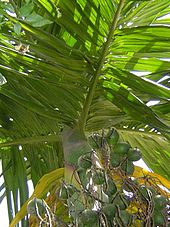Arecoline
| Structural formula | |||||||||||||
|---|---|---|---|---|---|---|---|---|---|---|---|---|---|

|
|||||||||||||
| General | |||||||||||||
| Surname | Arecoline | ||||||||||||
| Molecular formula | C 8 H 13 NO 2 | ||||||||||||
| External identifiers / databases | |||||||||||||
|
|||||||||||||
| Drug information | |||||||||||||
| Drug class | |||||||||||||
| properties | |||||||||||||
| Molar mass | 155.19 g mol −1 | ||||||||||||
| Physical state |
firmly |
||||||||||||
| Melting point |
169–171 ° C (hydrobromide) |
||||||||||||
| solubility |
|
||||||||||||
| safety instructions | |||||||||||||
|
|||||||||||||
| As far as possible and customary, SI units are used. Unless otherwise noted, the data given apply to standard conditions . | |||||||||||||

Arecoline is a naturally occurring alkaloid in the seeds of betel nuts and, as a base, is an oily liquid. It was first isolated by Ernst Jahn in 1888 . Arecoline is the methyl ester of Arecaidins and acts on the autonomic nervous system acetylcholine receptor - agonist . The water-soluble salts (arecoline hydrobromide , arecoline hydrochloride ) were processed medicinally .
use
In many Asian cultures, immature betel nuts are chopped into small pieces, rolled in betel pepper leaves coated with slaked lime , and then chewed as betel bites. Arecoline as the active substance in it has a similar effect on the consumer as nicotine .
It was also used to deworm farm animals such as dogs. However, it is no longer used in this function. The salt (arecoline acetarsol ) , which is also difficult to absorb, was used.
effect
Arecoline has an effect comparable to that of nicotine , which, however, primarily acts on the nicotinic acetylcholine receptor , while arecoline is a partial agonist of the muscarinic acetylcholine receptors and thus primarily on the - responsible for the parasympathetic effects of the alkaloid such as pupillary constriction ( sphincterous constriction of the pupil , etc.), bronchial cones, etc. - Acetylcholine receptors M1, M2, M3 and M4 act.
Other toxins that act on acetylcholine receptors include: a. the anatoxin A of some cyanobacteria , the coniin of the spotted hemlock , cytisin of the golden rain , epibatidin of the poison dart frogs and curare .
synthesis
The possible synthesis takes place in several steps from formaldehyde , methylamine and acetaldehyde .
Individual evidence
- ↑ a b c data sheet Arecoline hydrobromide at Sigma-Aldrich , accessed on May 14, 2017 ( PDF ).
- ^ The Merck Index. An Encyclopaedia of Chemicals, Drugs and Biologicals. 14th edition, 2006, p. 127, ISBN 978-0-911910-00-1 .
- ↑ a b c Entry on Arecoline at Vetpharm, accessed on April 18, 2012.
- ^ Peter Nuhn: Naturstoffchemie , S. Hirzel Wissenschaftliche Verlagsgesellschaft, Stuttgart, 2nd edition, 1990, p. 563, ISBN 3-7776-0473-9 .
- ^ GWA Milne: Gardner's Commercially Important Chemicals: Definitions, Trade Names, and Properties . John Wiley & Sons, September 2, 2005, ISBN 978-0-471-73661-5 , pp. 44-.
- ↑ Pharmacotherapy in house and farm animals - Founded by W. Löscher, FR Ungemach and R. Kroker. W. Löscher, H. Potschka, A. Richter (Eds.) 9th edition, Georg Thieme Verlag 2014. p. 384.
- ↑ Yang YR, Chang KC, Chen CL, Chiu TH .: Arecoline excites rat locus coeruleus neurons by activating the M2-muscarinic receptor. . In: Chin J Physiol. . 43, No. 1, 2000, pp. 23-8. PMID 10857465 .
- ^ Xie DP, Chen LB, Liu CY, Zhang CL, Liu KJ, Wang PS .: Arecoline excites the colonic smooth muscle motility via M3 receptor in rabbits. . In: Chin J Physiol. . 47, No. 2, 2004, pp. 89-94. PMID 15481791 .
- ↑ KC Raffaele, A. Berardi, PP Morris, S. Asthana, JV Haxby, MB Schapiro, SI Rapoport, TT Soncrant: Effects of acute infusion of the muscarinic cholinergic agonist arecoline on verbal memory and visuo-spatial function in dementia of the Alzheimer type. In: Progress in neuro-psychopharmacology & biological psychiatry. Volume 15, Number 5, 1991, pp. 643-648, PMID 1956992 .
- ↑ R. Aráoz, J. Molgó, N. Tandeau de Marsac: Neurotoxic cyanobacterial toxins. In: Toxicon . Volume 56, Number 5, October 2010, pp. 813-828, doi : 10.1016 / j.toxicon.2009.07.036 , PMID 19660486 (review).
- ↑ BT Green, ST Lee, KD Welch, JA Pfister, KE Panter: Fetal muscle-type nicotinic acetylcholine receptor activation in TE-671 cells and inhibition of fetal movement in a day 40 pregnant goat model by optical isomers of the piperidine alkaloid coniine. In: The Journal of pharmacology and experimental therapeutics. Volume 344, Number 1, January 2013, pp. 295-307, doi : 10.1124 / jpet.112.199588 , PMID 23086230 .
- ^ RL Papke, F. Ono, C. Stokes, JM Urban, RT Boyd: The nicotinic acetylcholine receptors of zebrafish and an evaluation of pharmacological tools used for their study. In: Biochemical pharmacology. Volume 84, number 3, August 2012, pp. 352–365, doi : 10.1016 / j.bcp.2012.04.022 , PMID 22580045 , PMC 3372685 (free full text).
- ↑ V. Gerzanich, X. Peng, F. Wang, G. Wells, R. Anand, S. Fletcher, J. Lindstrom: Comparative pharmacology of epibatidine: a potent agonist for neuronal nicotinic acetylcholine receptors. In: Molecular pharmacology. Volume 48, Number 4, October 1995, pp. 774-782, PMID 7476906 .
- ^ A. Trautmann: Curare can open and block ionic channels associated with cholinergic receptors. In: Nature. Volume 298, Number 5871, July 1982, pp. 272-275, PMID 6283380 .
- ^ The Alkaloids: Chemistry and Physiology V1: Chemistry and Physiology . Academic Press, January 1, 1965, ISBN 978-0-08-086525-6 , pp. 174ff.
